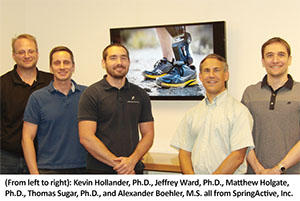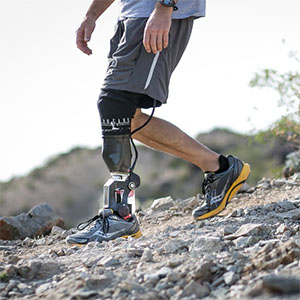


Posted July 7, 2015
Kevin Hollander, Ph.D., Jeffrey Ward, Ph.D., Matthew Holgate, Ph.D., Thomas Sugar, Ph.D., and Alexander Boehler, M.S.; SpringActive, Inc.
 Of the estimated 1.8 million Americans who have suffered limb loss, the majority have lost all or part of a leg/foot. Many Service members injured in the conflicts in Iraq and Afghanistan are part of that population. For this young and active group, the loss of a lower limb can be particularly troubling. This loss is reflected in slower walking speed, difficulty navigating uneven terrain (slopes, stairs), and reduced stability with increased risk of falling. Secondary effects from adjusting walking style to rely on the sound leg can be knee and hip replacement surgeries, osteoarthritis and osteoporosis, reduced activity levels leading to weight gain, and lower back pain. A well-designed prosthesis can mitigate these outcomes by providing a more natural walking style. Providing the flexion of a natural joint is an important part of prosthesis design.
Of the estimated 1.8 million Americans who have suffered limb loss, the majority have lost all or part of a leg/foot. Many Service members injured in the conflicts in Iraq and Afghanistan are part of that population. For this young and active group, the loss of a lower limb can be particularly troubling. This loss is reflected in slower walking speed, difficulty navigating uneven terrain (slopes, stairs), and reduced stability with increased risk of falling. Secondary effects from adjusting walking style to rely on the sound leg can be knee and hip replacement surgeries, osteoarthritis and osteoporosis, reduced activity levels leading to weight gain, and lower back pain. A well-designed prosthesis can mitigate these outcomes by providing a more natural walking style. Providing the flexion of a natural joint is an important part of prosthesis design.
The ankle provides more of the power for walking than either the knee or hip, acting like a spring that captures the energy of a foot fall and actively propels the push-off for the next step. The ability of the ankle to flex in all directions also provides stability on sloping or uneven ground. Early designs for prosthetic feet stored some walking energy to provide a passive spring assist to the push-off of the next step, but the power provided could not be controlled by the user and was not enough to completely power push-off. In addition, the foot was in a fixed orientation suitable only for walking on level ground.
To address these shortcomings, SpringActive developed a computer controlled ankle-foot prosthesis called Odyssey, which uses battery power, sensors, motors, and springs to produce natural walking motions for lower limb amputees. Dr. Jeffrey Ward and the team of SpringActive received a fiscal year 2011 award under the Clinical and Rehabilitative Medicine program area to enhance Odyssey by making it more rugged, with a better range of motion and a longer battery life, while also reducing its weight. The ruggedized Odyssey is intended to be usable by active duty Service members in the field.
Like a natural foot/ankle, the Odyssey captures the energy of walking in a titanium spring and adds a battery-powered motor to cooperate with the spring in providing power for push-off. Electronic sensors provide information on the user's speed so that the appropriate level of power is provided to sustain or modify that speed. As demonstrated by an amputee volunteer, the Odyssey ankle allowed the user to walk forward and backward, hop, and transition between forward walking and running at speeds up to 6 miles an hour. Dr. Ward and colleagues have been replacing components of the ankle to increase its durability under stress, and to increase the user weight supported to 220 pounds. An additional aim of the project is to make the Odyssey water-resistant and ultimately submersible. As the team replaces components to meet these aims, they will also work to reduce the overall device weight while increasing the performance life of the ankle.
As part of a plan to provide different foot components for different user needs, the SpringActive team sourced a new carbon fiber foot from Ossür, resulting in a fruitful partnership. Ossür and SpringActive recently announced a multi-year licensing agreement, in which Ossür will be involved in final design, manufacturing, and commercialization of the powered ankle. The partnership will provide impetus to reach Dr. Ward's vision of providing near able-bodied gait dynamics to wounded Soldiers and Veterans for walking and running.















